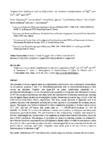Mostrar el registro sencillo del ítem
Sulphur-rich functionalized calix[4]arenes for selective complexation of Hg2+ over Cu2+, Zn2+ and Cd2+
| dc.contributor.author | Bensenane, Bachir | |
| dc.contributor.author | Asfari, Zouhair | |
| dc.contributor.author | Platas-Iglesias, Carlos | |
| dc.contributor.author | Esteban-Gómez, David | |
| dc.contributor.author | Djafri, Fatiha | |
| dc.contributor.author | Elhabiri, Mourad | |
| dc.contributor.author | Charbonnière, Loïc J. | |
| dc.date.accessioned | 2017-10-31T14:18:38Z | |
| dc.date.available | 2017-10-31T14:18:38Z | |
| dc.date.issued | 2016-08-16 | |
| dc.identifier.citation | Sulphur-rich functionalized calix[4]arenes for selective complexation of Hg2+ over Cu2+, Zn2+ and Cd2+. B. Bensenane, Z. Asfari, C. Platas-Iglesias, D. Esteban-Gómez, F. Djafri, M. Elhabiri and L. J. Charbonnière, Dalt. Trans., 2016, 45, 15211–15224. | es_ES |
| dc.identifier.issn | 1477-9226 | |
| dc.identifier.issn | 1477-9234 | |
| dc.identifier.uri | http://hdl.handle.net/2183/19671 | |
| dc.description.abstract | [Abstract] The syntheses of two new ligands based on a calix[4]arene scaffold in the cone conformation functionalized on the phenolic positions 1 and 3 by diethylthiophosphonates (L1) or tetra(tri)thioethyleneglycol (L2) crowns are described. Together with ligand L3, the parent calix[4]arene substituted by a penta(tetra)thioethyleneglycol crown, the spectroscopic properties of the ligands were determined by means of UV-Vis absorption spectroscopy and steady-state and time-resolved fluorescence spectroscopy, showing that the ligands display modest but non-negligible intrinsic fluorescence properties (ϕfluo = 0.023; 0.026 and 0.029 for L1, L2 and L3 in CH2Cl2, respectively). The X-ray crystal structures of ligand L1, and of its synthetic precursor were determined and analyzed for their capacity to accommodate the incoming cationic species. The ligands were further investigated for their complexation properties of divalent cations such as Cu2+, Zn2+, Hg2+ and Cd2+ (under their nitrate salts) in 1:1 CH3CN/CH2Cl2 solutions (I = 0.01 M Et4NNO3, T = 25.0(2) °C), in which the additions of cations were monitored by absorption and steady-state fluorescence spectrophotometries. The stoichiometries of the corresponding complexes were assessed by ESI-MS, while insights into the structures of the complexes in solution were obtained with density functional theory (DFT) calculations. The influence of the sulphur and phenol coordinating moieties was addressed to show that the thiocrown compounds L2 and L3 displayed a marked affinity towards the soft mercuric cation (ΔlogK ≥ 2), with no particular size selectivity effect, whereas ligand L1 can accommodate both the thio and phenol units to coordinate with Cu(II). Altogether, these results point to the use of L3 as a selective fluoroionophore for detection of Hg2+. | es_ES |
| dc.language.iso | eng | es_ES |
| dc.publisher | Royal Society of Chemistry | es_ES |
| dc.relation.uri | https://doi.org/10.1039/C6DT02628A | es_ES |
| dc.subject | Calix[4]arenes | es_ES |
| dc.subject | DFT calculations | es_ES |
| dc.subject | Heavy-metal complexes | es_ES |
| dc.subject | Stability constants | es_ES |
| dc.subject | Thiocrown ethers | es_ES |
| dc.title | Sulphur-rich functionalized calix[4]arenes for selective complexation of Hg2+ over Cu2+, Zn2+ and Cd2+ | es_ES |
| dc.type | info:eu-repo/semantics/article | es_ES |
| dc.rights.access | info:eu-repo/semantics/openAccess | es_ES |
| UDC.journalTitle | Dalton Transactions | es_ES |
| UDC.volume | 45 | es_ES |
| UDC.issue | 38 | es_ES |
| UDC.startPage | 15211 | es_ES |
| UDC.endPage | 15224 | es_ES |
Ficheros en el ítem
Este ítem aparece en la(s) siguiente(s) colección(ones)
-
GI-REACT! - Artigos [113]






